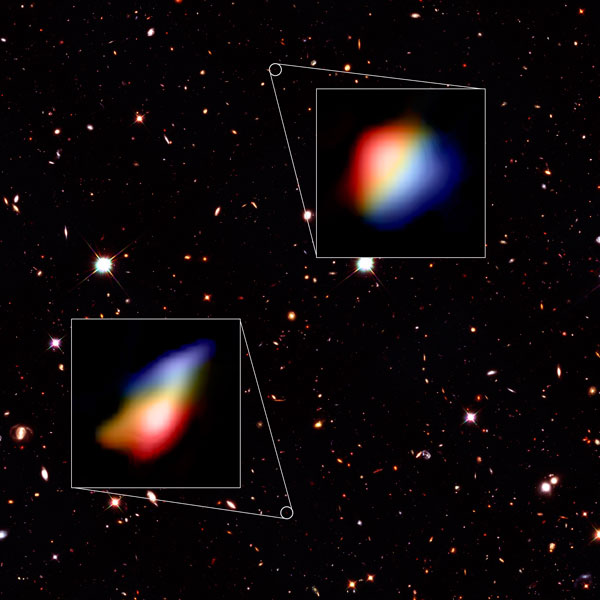New observations of galaxies in a universe just 800 million years old show that they’ve already settled into rotating disks. They must have evolved quickly to display such surprising maturity.

Hubble (NASA/ESA), ALMA (ESO/NAOJ/NRAO), P. Oesch (University of Geneva) and R. Smit (University of Cambridge)
Our cosmos was a messy youngster. Hotter and denser than the universe we live in now, it was home to turbulent gas flinging about under the influence of gravity. Theorists think the earliest galaxies built up gradually, first clump by clump, then by mergers with other galaxies.
Astronomers expected that most galaxies living among this early chaos would be turbulent masses themselves. But new observations have revealed two surprisingly mature galaxies when the universe was only 800 million years old. Renske Smit (University of Cambridge, UK) and colleagues report in the January 11th Nature that these two galaxies have already settled into rotating disks, suggesting they evolved rapidly right after they were born.
Smit and colleagues first found the two galaxies in deep Spitzer Space Telescope images, then followed up using the Atacama Large Millimeter/submillimeter Array (ALMA), a network of radio dishes high in the Atacama Desert in Chile. ALMA’s incredible resolution enabled the astronomers to measure radiation from ionized carbon — an element associated with forming stars — across the face of these diminutive galaxies.
Consider for a moment: These galaxies are a fifth the size of the Milky Way, and they’re incredibly far away — their light has traveled 13 billion years to Earth. Even in images taken by the eagle-eyed Hubble Space Telescope, such galaxies appear as small red dots. Yet astronomers are now able to point an array of radio dishes to not only spot the galaxies themselves but also capture features within them down to a couple thousand light-years across.
They Grow Up So Fast
The ALMA observations revealed that these two galaxies aren’t the turbulent free-for-all that astronomers expect for most galaxies in this early time period. Their rotating disks aren’t quite like the Milky Way’s, as spiral arms take time to form. Instead, they look more like the fluffy disk galaxies typically seen at so-called cosmic noon, the universe’s adolescent period of star formation and galaxy growth. That implies rapid evolution, as cosmic noon occurred more than 2 billion years after these two galaxies existed.
Simulations had predicted that it’s possible for some galaxies to evolve more quickly than their peers, notes Nicolas LaPorte (University College London), but it had never been observed before. “This paper represents a great leap forward in the study of the first galaxies,” he says.
Smit says that these two galaxies seem to stand out from their cohort, which makes sense given their quick growth: Among other things, they’re forming tens of Suns’ worth of stars every year, more than is typical for their time period. Smit is already planning additional observations to see just how different these galaxies are from their peers.
 5
5
Comments
Rod
January 15, 2018 at 8:02 pm
Good report. In observational astronomy we do not see the primordial gas clouds from the big bang or Population III stars composed of H,He, and Li but no carbon. Carbon is observed so we must assume it formed via s-process or r-process in earlier generation(s) of stars that were primordial perhaps. However, if the carbon is primordial too, well BBN has problems 🙂
You must be logged in to post a comment.
Frank-Schmidt
January 16, 2018 at 9:25 pm
perhaps we need to revisit the age the universe?
You must be logged in to post a comment.
santaklaus
January 20, 2018 at 2:58 am
Yes. May be inflation is not a good model and the Universe is old than we think. May be their growth as been more slow and their age bigger. This is a clue. Another is the rapid formation of black holes.
Or may be the growth rate has been variable along the time.
I think the actual models are too simple.
You must be logged in to post a comment.
Rod
January 17, 2018 at 9:32 am
It seems the age of the universe in the big bang is calculated chiefly by expansion rates arriving at 13.8 billion years old universe. We must know the expansion time from initial area of our universe <= Planck length, expansion rate and time to origin of CMBR, and expansion rate and time interval from CMBR until the present. To evolve out of the Planck length, the big bang created 3-D space instantaneously. After the instantaneous creation of 3-D space epoch as I like to call it, we have the inflation epoch expansion rate and time interval. After inflation epoch, we have a much slower rate of expansion and time interval until the CMBR is formed. After the CMBR forms, we have some billions of years of expansion at the slower rate followed by some billions of years of expansion at an accelerated rate until present. All of these different, 3-D space expansion rates need to be sorted out.
You must be logged in to post a comment.
Rick
January 27, 2018 at 7:38 pm
1. Typically, Monica Young is simple, straightforward, and clear. Well done.
2. I agree that the age of the universe needs to be re-visited. while the expansionist era fits the mathematical models, there must be an explanation of how the expansionist phase could start and then stop. It MUST be clarified, explained, and justified before it is accepted.
Richard Littleton
You must be logged in to post a comment.
You must be logged in to post a comment.